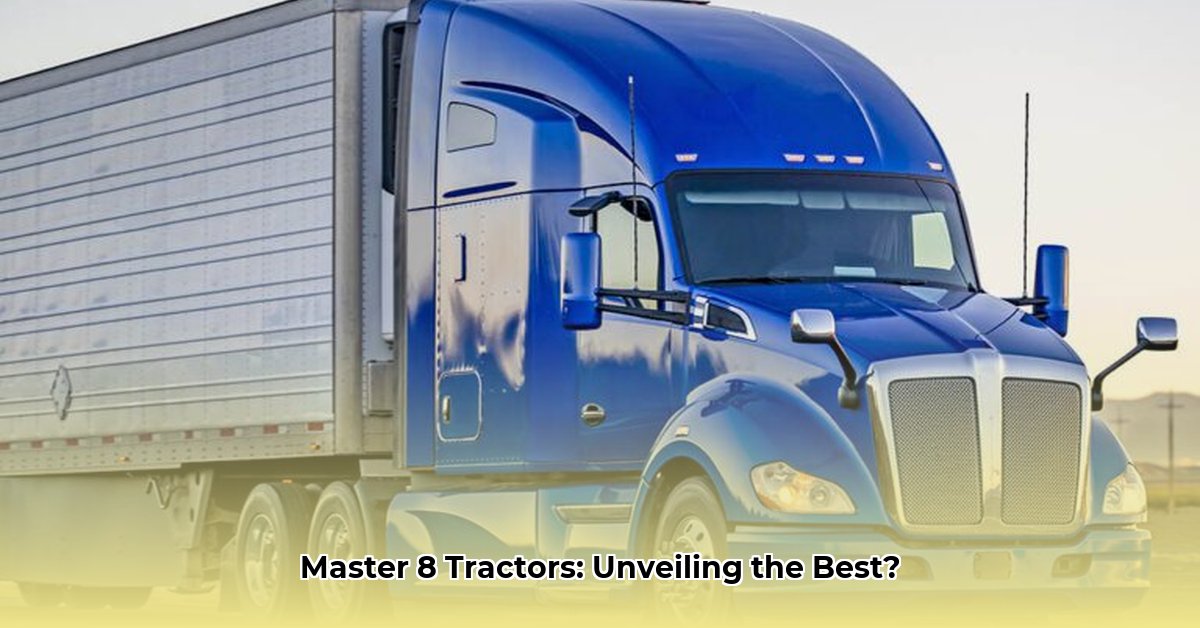
Class 8 Tractors: Understanding the Heavyweight Champs of Agriculture
Class 8 tractors are the heavy hitters of the agricultural world, renowned for their immense power and capacity to handle large-scale farming tasks. While there's no universally standardized definition, the term generally refers to tractors exceeding 300 horsepower, built for robust performance and designed to pull massive farming implements. This designation signifies a machine built for serious work on large farms. For more information on smaller tractors, check out this resource.
Defining Characteristics of a Class 8 Tractor
Several key features distinguish Class 8 tractors:
- Exceptional Power: Horsepower ratings typically exceed 300, far surpassing smaller agricultural tractors.
- Massive Size and Weight: Their sheer size and weight enable effortless handling of heavy-duty equipment.
- Heavy-Duty Implement Capacity: Engineered to operate with the largest and most demanding agricultural implements.
- Advanced Technology Integration: Modern models often incorporate GPS guidance systems, automated steering, and other precision farming technologies for increased efficiency and yield.
Choosing the Right Class 8 Tractor: A Strategic Investment
Purchasing a Class 8 tractor is a major investment demanding careful consideration. The following steps ensure a wise purchase aligned with your farming operations:
Assess Your Farming Needs: Define your primary tasks (e.g., plowing, hauling). This clarifies the necessary tractor capabilities.
Develop a Realistic Budget: Class 8 tractors are expensive. Establish a firm budget before beginning your search to avoid impulsive overspending.
Factor in Maintenance Costs: Regular servicing is crucial. Include ongoing maintenance expenses in your budget to prevent unexpected downtime and financial strain.
Prioritize Dealer Support: Choose a reputable dealer with readily available parts and excellent customer service for prompt issue resolution.
Evaluate Technological Needs: Determine your requirements for precision farming technology (GPS, automated steering). These features enhance efficiency but increase costs.
Weighing the Pros and Cons: A Balanced Perspective
Class 8 tractors offer substantial advantages but also present certain drawbacks. A balanced perspective is crucial for informed decision-making.
| Advantages | Disadvantages |
|---|---|
| Superior power and efficiency | Extremely high initial purchase cost |
| Handles the heaviest implements | High fuel consumption |
| Advanced technology for increased productivity | Requires expensive and regular maintenance |
| Significantly boosts productivity | Demands specialized training and licensing |
| Reduces labor costs | High overall operating costs |
Navigating the Nuances of Class 8 Tractor Classification
The term "Class 8" lacks universal definition. Manufacturers use various terms (e.g., "heavy-duty," "super duty"), potentially differing from formal classifications. Always verify specifications directly with the manufacturer. Additionally, understand local and national regulations regarding licensing and operation for safe and compliant use. "Ignoring these regulations can lead to substantial fines and operational disruptions," warns Dr. Anya Sharma, Agricultural Engineering Professor at Purdue University.
Mastering International Commercial Truck Regulations
Operating a Class 8 tractor internationally requires navigating a complex regulatory landscape. This section details effective strategies for international compliance:
Understanding Weight Classifications: GVWR and GCWR
The Gross Vehicle Weight Rating (GVWR) – the maximum permissible weight of the vehicle, including payload – and the Gross Combination Weight Rating (GCWR) – the maximum weight of the tractor-trailer combination – are fundamental for regulatory compliance. Exceeding these limits results in penalties and safety risks. Weight limits vary significantly between countries, impacting route planning and efficiency.
Navigating Regional and International Regulations: A Step-by-Step Guide
Thorough Research: Investigate the specific regulations of each country where operation is planned. Government websites and industry associations are valuable resources.
Meticulous Documentation: Ensure all documentation (driver's licenses, registration, insurance, permits) is complete and readily accessible.
Strategic Route Planning: Plan routes considering weight restrictions, road conditions, and potential regulatory delays. Utilize GPS and route planning software designed for this purpose.
Strict Adherence to Regulations: Comply fully with all regulations to avoid fines, vehicle impoundment, and operational downtimes.
Key Considerations for International Operations
- Permitting: Obtain necessary permits for oversized or overweight loads well in advance.
- Insurance Coverage: Secure comprehensive insurance covering international operations.
- Driver Training: Provide robust training to drivers on international regulations and route-specific requirements.
- Technological Aids: Leverage technology (GPS, telematics) for compliance tracking and route optimization.
Three Pivotal Points for Success with Class 8 Tractors:
- Thoroughly understand and comply with all relevant regulations, both domestically and internationally.
- Factor in the long-term costs of ownership, including maintenance and fuel consumption, when budgeting.
- Choose a reliable dealer with strong service and parts support to minimize downtime.